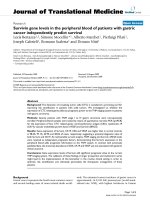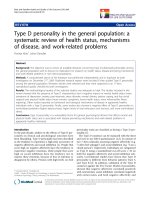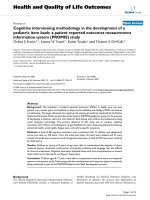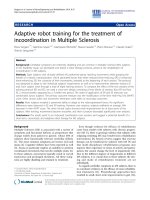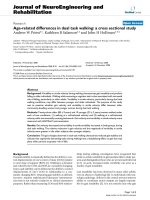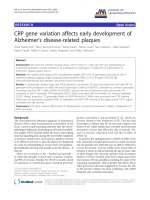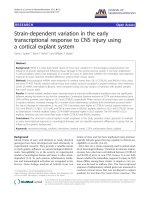báo cáo hóa học: " Cognitive interviewing methodology in the development of a pediatric item bank: a patient reported outcomes measurement information system (PROMIS) study" docx
Bạn đang xem bản rút gọn của tài liệu. Xem và tải ngay bản đầy đủ của tài liệu tại đây (241.77 KB, 10 trang )
BioMed Central
Page 1 of 10
(page number not for citation purposes)
Health and Quality of Life Outcomes
Open Access
Research
Cognitive interviewing methodology in the development of a
pediatric item bank: a patient reported outcomes measurement
information system (PROMIS) study
Debra E Irwin*
1
, James W Varni
2
, Karin Yeatts
1
and Darren A DeWalt
3
Address:
1
Department of Epidemiology, University of North Carolina at Chapel Hill, Chapel Hill, NC, USA,
2
Department of Pediatrics, College of
Medicine, Department of Landscape Architecture and Urban Planning, College of Architecture, Texas A&M University College Station, Texas, USA
and
3
Division of General Medicine and Clinical Epidemiology, Cecil G. Sheps Center for Health Services Research, University of North Carolina
at Chapel Hill, Chapel Hill, North Carolina, USA
Email: Debra E Irwin* - ; James W Varni - ; Karin Yeatts - ;
Darren A DeWalt -
* Corresponding author
Abstract
Background: The evaluation of patient-reported outcomes (PROs) in health care has seen
greater use in recent years, and methods to improve the reliability and validity of PRO instruments
are advancing. This paper discusses the cognitive interviewing procedures employed by the Patient
Reported Outcomes Measurement Information System (PROMIS) pediatrics group for the purpose
of developing a dynamic, electronic item bank for field testing with children and adolescents using
novel computer technology. The primary objective of this study was to conduct cognitive
interviews with children and adolescents to gain feedback on items measuring physical functioning,
emotional health, social health, fatigue, pain, and asthma-specific symptoms.
Methods: A total of 88 cognitive interviews were conducted with 77 children and adolescents
across two sites on 318 items. From this initial item bank, 25 items were deleted and 35 were
revised and underwent a second round of cognitive interviews. A total of 293 items were retained
for field testing.
Results: Children as young as 8 years of age were able to comprehend the majority of items,
response options, directions, recall period, and identify problems with language that was difficult
for them to understand. Cognitive interviews indicated issues with item comprehension on several
items which led to alternative wording for these items.
Conclusion: Children ages 8–17 years were able to comprehend most item stems and response
options in the present study. Field testing with the resulting items and response options is presently
being conducted as part of the PROMIS Pediatric Item Bank development process.
Background
The Patient Reported Outcomes Measurement Informa-
tion System (PROMIS) project, a National Institute of
Health Roadmap for Medical Research initiative, was
developed to advance the science and application of
patient-reported outcomes (PRO) in chronic diseases [1].
Published: 23 January 2009
Health and Quality of Life Outcomes 2009, 7:3 doi:10.1186/1477-7525-7-3
Received: 1 April 2008
Accepted: 23 January 2009
This article is available from: />© 2009 Irwin et al; licensee BioMed Central Ltd.
This is an Open Access article distributed under the terms of the Creative Commons Attribution License ( />),
which permits unrestricted use, distribution, and reproduction in any medium, provided the original work is properly cited.
Health and Quality of Life Outcomes 2009, 7:3 />Page 2 of 10
(page number not for citation purposes)
The process of developing item banks for PROMIS
includes literature review, focus groups, and individual
cognitive interviews [2-4]. Among the qualitative meth-
ods, cognitive interviewing allows direct input from
respondents on the item content, format, and understand-
ability. This method has emerged as an essential compo-
nent in the development of a number of standardized
measures [5-7].
The cognitive interviewing methodology for PROMIS was
designed to elicit input from respondents on all items
under consideration for the PROMIS item bank [3]. The
pediatric cognitive interviewing methodology followed
the general principles of the PROMIS Network [3], with
the necessary adaptations required for children as young
as 8 years of age, relying in part on the cognitive interview-
ing methodology utilized in the development of the Ped-
sQL™ instruments [8] and the work of Willis [9].
The cognitive interviewing methodology is designed to
assess the cognitive processes underlying respondents'
comprehension and generation of answers to question-
naire items within an information processing conceptual
model [10]. The intent of cognitive interviewing is to
determine what the respondent thinks or comprehends a
particular item is asking (what do specific words and
phrases in the item stem mean to the respondent); the
processes used by the respondent to retrieve relevant
information from autobiographical memory; the decision
or judgment processes used to conceive an answer; and
the process of formulating a response to the item stem
[10-13].
Although there are two major types of cognitive interview-
ing methods (think-aloud and respondent debriefing),
the PROMIS cognitive interviews employed the respond-
ent debriefing technique [7]. In this technique, after a par-
ticipant completes the questionnaire, an interviewer
probes for specific information on what types of difficul-
ties respondents experienced while completing the items,
and the basis for the response for each item [9]. Cognitive
probes elicit information regarding the clarity and ration-
ale of the directions, the meaning of the items, the appro-
priateness of the response choices, and overall comments
on the relevance and complexity of the questionnaire
[12,13].
The primary objective of this study was to conduct cogni-
tive interviews with children and adolescents to gain feed-
back on items measuring physical functioning, emotional
health, social health, fatigue, pain, and asthma-specific
symptoms.
Methods
Item development
The PROMIS Pediatrics project focused on the develop-
ment of PRO item banks across several health domains for
youth ages 8–17 years. Initially, PROMIS focused on the
measurement of generic health domains that are impor-
tant across a variety of illnesses, including physical func-
tion, pain, fatigue, emotional distress, and social function
[2]. Since asthma is the most common chronic disease of
childhood, and PRO measurement is an essential compo-
nent of evaluation of outcomes for children with asthma
[14-16], asthma was an excellent chronic condition for
the initial development of the PROMIS pediatrics disease
specific item bank.
The PROMIS item bank was developed using a strategic
item generation methodology. A series of focus groups
were conducted to generate themes and domains [4]; a lit-
erature review was conducted to identify existing pediatric
health questionnaires; and discussions with health care
and research personnel (including physicians, psycholo-
gists, social workers, epidemiologists and nurses) were
utilized to identify an initial item pool of over 3345 items.
These items were "binned" (i.e., items were classified into
domains according to their content) and "winnowed"
(items were eliminated that either lacked face validity for
the domain or were very similar to a more ideally worded
item) [2,3] by the PROMIS pediatric project team. Items
were rewritten or modified to adhere to a set of formatting
requirements accepted by the PROMIS development team
(e.g., use of past tense, 7 day recall period, standard
response options (see Table 1 for response options uti-
lized)). Cognitive interviews were conducted on the
resulting 318 items across 6 domains, after which 35
items were revised and underwent a second round of cog-
nitive interviews. The final item set contained 293 items
Table 1: Item response options
Frequency
Never
Almost Never
Sometimes
Often
Almost Always
Difficulty (or interference)
With no trouble
With a little trouble
With some trouble
With a lot of trouble
Not able to do
Numeric Rating: 0–10
# of Days: 0,1,2,3,4,5,6,7
Health and Quality of Life Outcomes 2009, 7:3 />Page 3 of 10
(page number not for citation purposes)
across 6 domains (Physical Function = 70 items; Emo-
tional Health = 49 items; Social Health = 74 items; Fatigue
= 39 items; Pain = 27 items; Asthma = 34 items).
Participants
To participate in the cognitive interviews at The Children's
Hospital at Scott and White (S&W) and the University of
North Carolina (UNC), participants needed to meet the
following criteria: between the ages of 8 and 17 years
inclusive; speak and read English; provide informed
assent prior to study entry; and provide parent or guardian
informed consent. We also recruited children with asthma
to review all domain items and asthma-specific items. Par-
ticipants were not eligible for the study if they had any
concurrent medical, psychiatric or cognitive conditions
that, in the investigator's opinion, would interfere with
participation in this study.
Purposive sampling was used to recruit a total of 28 chil-
dren and adolescents from the UNC (6 with asthma; 22
without asthma) hospital and community clinics and 37
children and adolescents from the general pediatric clinic
at S&W (16 with asthma; 21 without asthma), who partic-
ipated in the first round of cognitive interviews. For the
second round of cognitive interviews, 18 children and
adolescents from S&W and 5 children from UNC partici-
pated (11 of these 23 participated in first round inter-
views). Table 2 lists the demographic characteristics of the
first round cognitive interview participants from each site.
For each domain questionnaire, the cognitive interview
sample included at least 2 children 8 or 9 years of age, 1
adolescent between 13 and 18 years, 2 children of non-
white ethnicity, and 1 child of white/Caucasian ethnicity.
These categories were not exclusive. For example, a Latina
girl age 8 would fulfill both the racial/ethnic requirement
and the age requirement.
Recruitment procedures
At both UNC and the S&W, potential participants were
identified through review of clinic appointment books. A
research assistant then mailed an informational letter to
the child's parent to inform them about the study. Those
who were interested in participating contacted the study
coordinator to schedule their interview time. If the child
was deemed eligible to participate in the cognitive inter-
view and the parents agreed to allow their child to partic-
ipate, they were scheduled for an interview date. At the
time of the interview, a trained research assistant obtained
parental informed consent and the children signed an
assent document. All child participants received a $25 gift
card in return for their time and effort. Children were
allowed to take a break or end the interview at any time,
although no children ended the interview prematurely.
The study protocols were approved by the institutional
Table 2: Participant demographics and clinical characteristics for
first round cognitive interviews
NC (N = 28 (%) TX (N = 37 (%)
Gender – Male 14 (50) 19 (51)
Age
8–9 years 11 (39) 13 (35)
10–12 years 8 (29) 16 (43)
13–17 years 9 (32) 8 (22)
Grade Completed in School
1
st
or less 0 1 (3)
2
nd
– 5
th
20 (71) 24 (65)
6
th
– 11
th
8 (29) 12 (32)
Reading Level*
2
nd
– 5
th
7 (25) 14 (38)
6
th
– 8
th
14 (50) 8 (22)
High School 5 (18) 9 (24)
Post- High School 2 (7) 5 (14)
Missing 0 1 (2)
Race
Caucasian 19 (68) 28 (76)
African American 5 (17) 2 (5)
Asian 3 (11) 0
Other – Mixed 1 (4) 7 (19)
Ethnicity – Hispanic 2 (7) 10 (27)
Guardian Status
Divorced 6 (21) 2 (5)
Separated 2 (7) 5 (14)
Married 15 (54) 25 (68)
Never married 5 (18) 4 (11)
Living with partner 0 1 (2)
Guardian Education Status
Advanced degree 6 (21) 7 (19)
College 18 (65) 5 (13)
Some college/AA 0 21 (57)
High School 4 (14) 4 (11)
Guardian Occupation
Full-Time Employed 16 (57) 27 (73)
Homemaker 7 (25) 2 (7)
Part Time Employed 3 (11) 6 (16)
Unemployed 2 (7) 0
Full time student 0 1 (2)
FT emp & PT student 0 1 (2)
Asthma 6 (21) 16 (43)
*based on WRAT score
Health and Quality of Life Outcomes 2009, 7:3 />Page 4 of 10
(page number not for citation purposes)
review boards at UNC (#05-1431) and at S&W (#05-
0077).
Cognitive interviewing process
The interviewers utilized for this study underwent an
extensive training session (16 hours) that included gen-
eral information on cognitive interview theory and proce-
dures, as well as pediatric specific procedures. Interviewers
were graduate students in social work or research nurses
all who had experience working with children in pediatric
research settings. All interviewers were trained by a pedi-
atric psychologist with extensive experience in children's
therapy and qualitative questionnaire development. Inter-
views were conducted in a comfortable environment and
breaks were offered for the children.
We applied a sampling scheme that allowed each partici-
pant to be interviewed on approximately 30 items rather
than all 318 items. Each child evaluated items from only
one or two domains and only one response scale. By this
method, all items in the bank were reviewed by at least 5
participants (59% of items were reviewed by 5 participant;
34% were reviewed by 6 participants; 7% were reviewed
by 7 participants) meeting the target demographic charac-
teristics outlined above (see Participants Section). During
the cognitive interviews, participants were asked to pro-
vide verbal open-ended feedback on each item regarding
response categories, time frame, item interpretation and
overall impression of domain content and coverage.
Parents were asked to complete a sociodemographic form
which contained information regarding the child's age,
gender, ethnicity, living situation, and chronic health con-
dition(s) as well as the parent/guardian's employment
and education. Parents of children with asthma also com-
pleted an asthma form, which contained information
about the number of days and nights in the previous week
the child had coughing, wheezing, or shortness of breath,
the number of times in the previous week the child used
rescue medication, and the types of medications the child
was taking. These demographic characteristics are
described in Table 2.
Other than the children with asthma who underwent the
cognitive interview on the asthma-specific item set, partic-
ipants were randomly assigned to receive an item set
(approximately 30 items) selected from one of the
domains. Prior to the cognitive interview, participants
completed an item set through paper and pencil adminis-
tration. A research assistant trained in cognitive interview-
ing techniques then reviewed each item stem and item
response with the child and began the interview using
standardized questions (see Table 3) for each item. A sub-
set of participants were asked questions about preference
of item tense (past vs. present). The participant's compre-
Table 3: Cognitive interview questions
Directions
How would you make the directions more clear/easy to understand?
What does "in the past 7 days" mean to you?
When you see "the last 7 days", what days did you include?
Items
In your own words, what do you think this question is asking?
What does this question mean to you? What did you think of when answering this question?
Was this question easy to understand? Are there any specific words that are difficult to understand?
How would you change the words to make it more clear?
Was this item hard to answer? If yes, why?
How did you choose your answer?
Domains
In your own words, what do you think this group of questions is asking about?
How do you think these items are related?
Are there any questions that don't belong in this group?
Response Choices
What do you think about the response choices?
How would you make the response choices clearer or easier to understand?
Overall Assessment
Are there things that we forgot to ask about that you think are important?
Overall thoughts/opinions of the questionnaire?
Anything you would change in the questionnaire as a whole?
Health and Quality of Life Outcomes 2009, 7:3 />Page 5 of 10
(page number not for citation purposes)
hension or interpretation of the item along with their
preferences on recall options and recall time period was
elicited. All participant answers were recorded on a com-
puterized spreadsheet. At the end of the interview, partic-
ipants completed the Wide Range Achievement Test-3
Reading Subtest (WRAT) as a gross measure of reading
ability [17]. Interviews were also audio-taped to ensure
accuracy of interviewer notes.
Data analysis and item revision
After each interview, project personnel completed a sum-
mary statement for each item and the child's comments.
After completing all initial cognitive interviews for an
item, project personnel compiled reports that included all
comments for an item. The item development team then
reviewed all of the comments to determine issues with
formatting, item comprehension, instructions, tense, and
response options (see Table 4). Items deemed problem-
Table 4: Common issues identified by participants in first round of interviews
General Formatting Issues
Make the words larger
Issues with Instructions
Put recall period in bold type
Instructions are too long
Young children didn't understand the words "questionnaire" or
"accurate"
Item Comprehension Issues: Word Meaning
Problematic Word Suggested Change
"clothing drawers" "dresser drawers"
"irritable" "grumpy", "cranky"
"worry" "scared"
"stressed" "mad", "upset"
"exhausted" "tired"
"how severe" "how bad"
"social activities" "activities with friends"
"ER" "emergency room"
"grumpy" "mad", "angry"
"rely" "trust"
"furious" "angry", "mad"
"frustrated" "grouchy", "mad"
"frightened" "scared", "afraid"
"snaps" (i.e., shirt snaps) "zipper", "button"
Item Comprehension Issues: Vague/Ambiguous Words/
Phrases
ProblematicWords/Phrases Explanation
"activities" Could mean sports or hobbies (i.e., crafts)
"clothes" Could mean pants, shirts, or both
"walk" Could be a block or a mile
"hard to have fun" Doesn't specify if it's hard due to physical or emotional issues
"did things" Isn't specific. What kinds of things?
"go out" Could mean going outside (i.e., to play) or going out with family/friends
(i.e., to dinner)
"relationships" Could mean relationships with friends, family, teachers, or others
"others" Could mean friends, family, teachers, strangers, or others
"I felt like I did everything badly" Unclear if it is due to poor performance or if they got in trouble
"I felt so bad that I didn't want to do anything" Unclear if "bad" referred to physical health, guilt/shame, or low self-
esteem.
"feel terrible" Could mean physically or emotionally
Issues with Item Tense
Past tense items were preferred over present tense items
Misc. Issues
Assistive device items (i.e., questions about using a walker or
wheelchair) didn't apply to a large number of children
Note: All issues in above table were identified by at least 2 children
Health and Quality of Life Outcomes 2009, 7:3 />Page 6 of 10
(page number not for citation purposes)
atic by two or more children of any age were revised for
clarity. Other items similar to those revised after the initial
interview process were also changed by project personnel
to maintain consistency across item stems or wording. In
all, 35 items were revised as a result of the first round of
cognitive interviews.
To ensure comprehension of the 35 revised items, a sec-
ond set of cognitive interviews was conducted. Project per-
sonnel then reviewed the revised items and participants'
responses from the second review. Items that continued to
be problematic to research participants after the second
round were eliminated from the item bank. Table 5 shows
the 22 items that were retained in the final item bank and
revised after the second round of cognitive interviews,
along with the reasons for revising the items.
Results
Children who participated in the cognitive interviews
spent approximately 1 hour with each interviewer, with
some children (for example, younger children who took
breaks) requiring additional time. In general, even chil-
dren as young as 8 could understand the majority of the
items (293/318 = 92%) and response options, indicating
that they could think about and discuss their own health.
Although younger children had a more difficult time with
specific words, they understood the purpose of the items
and response options and were able to provide alterna-
tives using their own vocabulary. They also had no diffi-
culty understanding that they needed to answer questions
while thinking about specific recall periods. Older chil-
dren seemed to clearly understand the majority of items
and response options, and had fewer comprehension dif-
ficulties than younger children.
Tables 4 and 5 outline common issues identified by par-
ticipants. Specific words (i.e., irritable, stressed) were dif-
ficult to comprehend for some children and items were
sometimes too vague or ambiguous to be clearly under-
stood. The majority of items (92%) were retained in the
item banks for further large scale testing.
There was no indication that children had difficulty with
the response options, except that younger children
seemed to misunderstand the word "difficulty". When
questioned, children were able to distinguish between the
different response options, indicating that they could
clearly identify variable levels of functioning, so the word
"difficulty" was changed to "trouble" in subsequent cog-
nitive interviews. Additionally, 48/53 (91%) of the chil-
dren reported that the 7 day recall period meant the
previous 7 days, and they responded to items accordingly.
A subset of children were probed on present and past
tense preferences for the item stems; 8 preferred the
present tense, 8 preferred the past tense, and 9 had no
stated preference when referring to the past 7 days. Partic-
ipants had an overall positive opinion of the items and
did not provide any suggestions for additional content
that was not included in the current item banks.
Discussion
These results confirm that children ages 8–17 can talk
about and respond to items asking them about their
health and well-being. They can also offer unique insight
into the understandability of the items. These findings are
consistent with other studies [5,6]. The majority of the
items were well comprehended by all age groups, but we
also identified several terms that were not well under-
stood by younger children. Items containing difficult
words or vague concepts were readily identified by the
children and led to important questionnaire changes.
We also received valuable feedback on the format of the
questionnaire, including increasing the font size for ease
of readability, shortening the instructions, and putting the
recall period in bold type. For some children, certain
items were not applicable to them; for example, one child
didn't have a computer at home, so he could not answer
items related to computer use. Similarly, items that asked
about walker or wheelchair use were not applicable to the
majority of children interviewed, so feedback was limited
for these items.
The sample included an almost equal distribution of chil-
dren in different age groups, and represented a diverse
population. One benefit of the sample is that it included
a number of children with asthma, ensuring that com-
ments from children with the most common chronic dis-
ease in the United States were included. The sample was
well balanced for socioeconomic status and race/ethnic-
ity, which is a strength of this study.
Our study is similar to other cognitive interview studies
for children's PRO instrument development. For example,
we found that younger children had more difficulty
understanding specific item words than older children,
particularly for words such as "irritable", "nervous" and
"worried". Children in our study also had difficulty
understanding ambiguous terms or phrases such as "did
things" and "activities". These findings are consistent with
other studies of child-reported health outcomes [5,18,19].
Additionally, like other studies, the children in our study
reported few issues with the response formats using up to
5 response options, and were able to respond to items
within the recall period [5]. On occasion, the PROMIS
pediatrics item development team had to decide what to
do if a suitable synonym or content description was not
available for substitution when a word was not well
understood by some children. For example, the idea of
"worry" is important content for the anxiety domain and
Health and Quality of Life Outcomes 2009, 7:3 />Page 7 of 10
(page number not for citation purposes)
Table 5: PROMIS pediatric revised items and reasons for revision
First Version Revised Version Reason(s) for the Revision
My parents had enough time for me. My parents spent enough time with me. Many of the children interpreted the question
as the actual amount of time their parents
spent with them – half of them revised the
questions to "spend time" rather than "had
enough time."
I was able to rely on my friends. I was able to count on my friends. Some of the children used words like "trust" or
"count on" to interpret the question. Two out
of six of the children said they weren't sure of
the meaning of "rely."
I felt socially accepted by other kids. I felt accepted by other kids my age. One of the children didn't know what "socially"
meant, but understood the question with it left
out.
I did things with other boys and girls. I did things with kids my age. All children found the question to be clear and
considered both sexes when answering it.
However, some defined their interactions with
the opposite sex differently than that of their
own – it seemed like since the question
mentioned the sexes independently it divides
the incidence of "doing things" with other
children. (I play sports with boys every
afternoon. I sometimes play with the girls in
gym).
I had enough time to meet friends. I had enough time to be with my friends. Three out of six of the children interpreted this
question as having time to spend with current
friends, two interpreted this as having the time
and opportunity to meet new friends, and one
child didn't know what this meant. There was
an obvious difference in interpretation because
of the word "meet."
I felt like I did everything badly. I felt like I couldn't do anything right Two of the children interpreted this as meaning
doing something that wasn't good enough,
while two others interpreted it as doing
something "bad" that was worthy of
punishment., and the remaining children
defined it as "feeling bad" and "my life has been
bad." There was a significant degree of
difference in interpretation because of the
word "badly."
How severe was your asthma? My asthma was really bad. Four out of six of the children had a difficultly
defining "severe" and three out of six suggested
rewording it to "How bad is your asthma."
Did you feel that you got easily exhausted? I tired easily because of my asthma. Three out of six of the children had trouble
defining or understanding the word
"exhausted" and used tired as a synonym to
interpret the question.
Did asthma bother you if you wanted to go
out?
My asthma bothered me when I was with my
friends.
Four out of six of the children defined "go out"
as going outside to do something or to play
outside. This resulted in some of the children
factoring the weather into the state of their
asthma. Another kid interpreted "go out" as
going to dinner or doing anything else outside
of the house. The interpretation was not
consistent and if factoring in weather, the
degree of variability is even higher.
Health and Quality of Life Outcomes 2009, 7:3 />Page 8 of 10
(page number not for citation purposes)
Did you feel terrible when you were out of
breath?
My body felt bad when I was out of breath. Some children thought that "feeling terrible"
was equivalent to feeling guilty after doing
something wrong.
Were you scared that you might have to go to
the ER?
I was scared that I might have to go to the
emergency room or hospital because of my
asthma.
One young child didn't know what ER meant.
I could use a mouse for the computer. I could use a mouse or touch pad for the
computer.
One child mentioned that he never used a
mouse, but did use a touch pad. Both should be
referred to since many laptop users may not
use a mouse.
I could drink without help. I could lift a cup to drink. * Item revised by project personnel for
consistency with other similar items
I could undo snaps. I could zip up my clothes. Three out of five of the children weren't sure
what the "snaps" were or what the question
was referring to. Some thought it was referring
to snaps on clothes, while others weren't sure
(example – snapping fingers.)
I could turn pages. I could turn pages in a book. All of the children mentioned books or
magazines when describing the meaning of the
question. Two out of five of the children
recommended rewording the question to
include "turn pages in a book."
I used a special built-up pencil to write. I used a pencil with a special grip to write. Many were confused about what a "built-up
pencil" is. One defined it as a thick pencil,
another thought it was a bendable pencil.
However, three out of the five mentioned that
they thought it maybe referring to a pencil grip
– indicating that it is likely a better descriptor.
I could walk to the bathroom. I could walk across the room. Two out of five of the children interpreted the
question as being able to find the bathroom and
another child referenced going to a bathroom
while attending an athletic event in a stadium.
I felt good about my relationship with
classmates.
I felt good about how I got along with
classmates.
Two out of five of the children said that
"relationship" is too hard to understand. A few
of the children re-worded it as meaning "to get
along" with others.
I worried about my relationships with friends. I worried about losing a friendship. Some of the children thought the word
"relationship" was too difficult. Also, they
interpreted the statement differently. One child
thought it meant to be concerned about
someone (for their safety or wellbeing), and
another thought it meant feeling the need to
impress them.
I argued with other kids. I got into a yelling fight with other kids. Two out of five of the children recommended
not using the word "argue." Three of the five
children re-worded the question using the
words "yelling" or "fighting."
I felt bad about my relationships with
classmates.
I felt bad about how I got along with
classmates.
The word "relationship" was dropped because
some thought it was too difficult to understand.
They also interpreted it differently; one
thought it meant to feel bad after arguing,
another thought it meant not liking or "feeling
good" about classmates.
Table 5: PROMIS pediatric revised items and reasons for revision (Continued)
Health and Quality of Life Outcomes 2009, 7:3 />Page 9 of 10
(page number not for citation purposes)
I got anxious when I went to bed at night. I worried when I went to bed at night. Two out of five of the children weren't sure
what anxious meant and recommended using a
different word.
Table 5: PROMIS pediatric revised items and reasons for revision (Continued)
it was kept in the item bank even though some children
noted problems. These items will be reviewed again after
large scale testing is completed and final decisions for
these items will be made at that time.
Our study has several limitations. First, each item received
a minimum of 5 cognitive interviews. Although we felt
this was sufficient, some authors suggest that 10 – 15
interviews are better [9]. Because of experience on previ-
ous scale development projects [5,18,19] with very similar
items we felt comfortable performing fewer overall inter-
views on these items. Since a minimal number of children
ages 8 or 9 were required to review the items, some impor-
tant findings for this age group could be missed. Secondly,
as with any qualitative study, the item development team
had to make judgments as to the importance of an item
problem and whether revisions were necessary. We tried
to adhere to the operationalization of two negative com-
ments leading to revision, but all such judgments are
inherently qualitative. Our team, however, was interested
in identifying the most clear and important items for
inclusion and carefully responded to all of the feedback
from the children. Lastly, the interview questions about
content validity were phrased very broadly and did not
add additional information to our previous studies utiliz-
ing focus groups [4].
Conclusion
Overall, the findings of the cognitive interviews suggest
that children as young as 8 years could respond to items
and talk about all aspects of their health and well-being in
meaningful ways. They are able to comprehend varying
response options on a categorical scale, and can accurately
respond to items using a 7-day recall period. Feedback
from the children who participated was valuable in creat-
ing a set of items to be administered to a wide age range
of children. The final item set generated as a result of the
cognitive interview process is currently undergoing large
scale testing as part of the PROMIS Pediatric Item Bank
development process.
Abbreviations
(PROMIS): Patient Reported Outcomes Measurement
Information System; (PROs): Patient-reported outcomes;
(S&W): Scott and White; (UNC): University of North
Carolina; (WRAT): Wide Range Achievement Test-3 Read-
ingSubtest; (PedsQL™): Pediatric Quality of Life Inven-
tory™.
Competing interests
The authors declare that they have no competing interests.
Authors' contributions
All authors have made substantial contributions to con-
ception and design, or acquisition of data, or analysis and
interpretation of data, been involved in drafting the man-
uscript or revising it critically for important intellectual
content; and have given final approval of the version to be
published.
Acknowledgements
We would like to acknowledge the contributions of Jin-Shei Lai PhD, Esi
DeWitt MD, Kelli Scanlon, Kelly Williams and Tasha Burwinkle PhD for
their contributions to reviewing items and cognitive interview data. We
would like to acknowledge the contribution of Harry A. Guess, MD, PhD
to the conceptualization and operationalization of this research prior to his
death.
This work was funded by the National Institutes of Health through the NIH
Roadmap for Medical Research, Grant 1U01AR052181-01. Information on
the Patient-Reported Outcomes Measurement Information System
(PROMIS) can be found at /> and
promis.org.
References
1. Ader DN: Developing the Patient-Reported Outcomes Meas-
urement Information System (PROMIS). Medical Care 2007,
45(Suppl 1):S1-S2.
2. Cella D, Yount S, Rothrock N, Gershon R, Cook K, Reeve B, Ader
DN, Fries JF, Bruce B, Rose M: The Patient-Reported Outcomes
Measurement Information System (PROMIS): Progress of
an NIH Roadmap Cooperative Group during its first two
years. Medical Care 2007, 45(Suppl 1):S3-S11.
3. DeWalt D, Rothrock N, Yount S, Stone AA, PROMIS Cooperative
Group: Evaluation of Item Candidates: The PROMIS qualita-
tive item review. Medical Care 2007, 45(Suppl 1):S12-S21.
4. Walsh TR, Irwin DE, Meier A, Varni JW, DeWalt D: The use of
focus groups in the development of the PROMIS Pediatric
Item Bank. Qual Life Res 2008, 17:T725-735.
5. Varni JW, Seid M, Rode CA: The PedsQL™: Measurement
model for the Pediatric Quality of Life Inventory. Medical Care
1999, 37:126-139.
6. Rebok G, Riley A, Forrest CB, Starfield B, Green BF, Robertson J,
Tambor E: Elementary school-aged children's reports of their
health: A cognitive interviewing study. Quality of Life Research
2001, 10:59-70.
7. Woolley ME, Bowen GL, Bowen NK: The development and eval-
uation of procedures to assess child self-report item validity.
Educational and Psychological Measurement 2006, 66:687-700.
8. Varni JW, Seid M, Kurtin PS: PedsQL 4.0: reliability and validity
of the Pediatric Quality of Life Inventory version 4.0 Generic
Core Scales in healthy and patient populations. Med Care
2001, 39(8):800-812.
9. Willis GB: Cognitive Interviewing: A Tool for Improving
Questionnaire Design. Thousand Oaks, CA: Sage Publications;
2005.
10. Jobe JB: Cognitive psychology and self-reports: Models and
methods. Quality of Life Research 2003, 12:219-227.
Publish with BioMed Central and every
scientist can read your work free of charge
"BioMed Central will be the most significant development for
disseminating the results of biomedical research in our lifetime."
Sir Paul Nurse, Cancer Research UK
Your research papers will be:
available free of charge to the entire biomedical community
peer reviewed and published immediately upon acceptance
cited in PubMed and archived on PubMed Central
yours — you keep the copyright
Submit your manuscript here:
/>BioMedcentral
Health and Quality of Life Outcomes 2009, 7:3 />Page 10 of 10
(page number not for citation purposes)
11. Tourangeau R, Rips LJ, Rasinski K: The Psychology of Survey
Response. Cambridge: Cambridge University Press; 2000.
12. Sudman S, Bradburn NM, Schwarz N: Thinking about answers:
The application of cognitive processes to survey methodol-
ogy. San Francisco: Jossey-Bass; 1996.
13. Schwarz N, Sudman N, (eds): Answering questions: Methodol-
ogy for determining cognitive and communicative processes
in survey research. San Francisco: Jossey-Bass; 1996.
14. Chan KS, Mangione-Smith R, Burwinkle TM, Rosen M, Varni JW: The
PedsQLTM: Reliability and validity of the short-form generic
core scales and asthma module. Med Care 2005, 43:256-265.
15. Guyatt GH, Juniper EF, Griffith LE, Feeny DH, Ferrie PJ: Children
and adult perceptions of childhood asthma. Pediatrics 1997,
99(2):165-168.
16. Juniper EF, Guyatt GH, Feeny DH, Ferrie PJ, Griffith LE, Townsend M:
Measuring quality of life in children with asthma. Qual of Life
Res 1996, 5(1):35-46.
17. Wilkinson GS: WRAT3 Wide Range Achievement Test
Administration Manual. Wilmington: Wide Range, Inc; 1993.
18. Woolley MF, Bowen GL, Bowen NK: Cognitive Pretesting and
the Developmental Validity of Child Self-Report Instru-
ments: Theory and Applications. Research on Social Work Practice
2004, 14:191-200.
19. Ravens-Sieberer U, Gosch A, Rajmil L, Erhart M, Bruil J, Duer W,
Auquier P, KIDSCREEN Group: KIDSCREEN-52 Quality of Life
Measure for Children And Adolescents. Expert Review of Phar-
macoeconomics and Outcomes Research 2005, 5:353-364.
